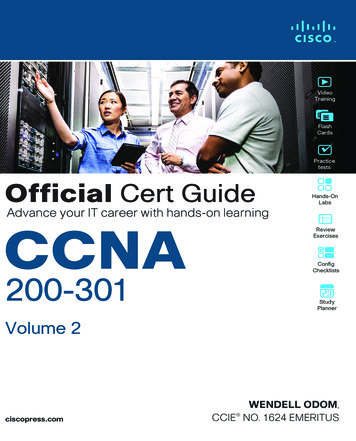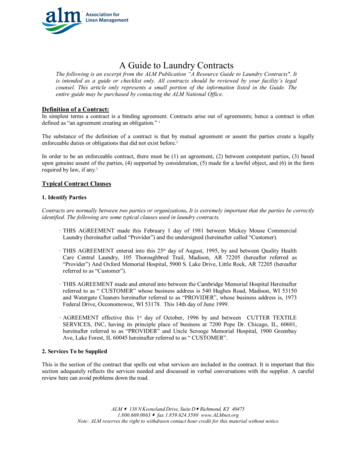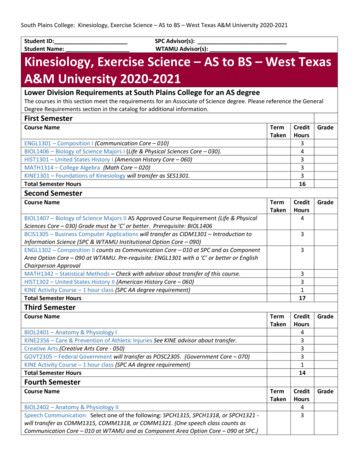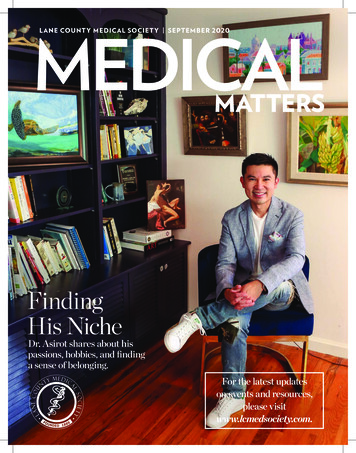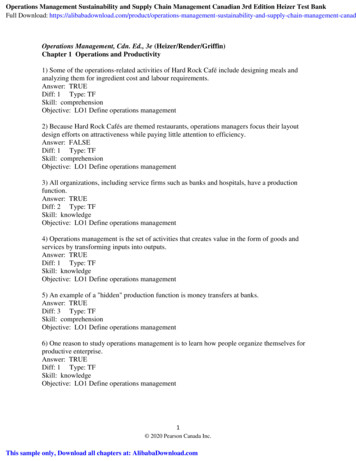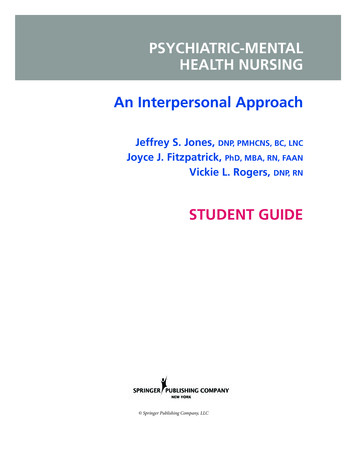
Transcription
PSYCHIATRIC-MENTALHEALTH NURSINGAn Interpersonal ApproachJeffrey S. Jones, DNP, PMHCNS, BC, LNCJoyce J. Fitzpatrick, PhD, MBA, RN, FAANVickie L. Rogers, DNP, RNSTUDENT GUIDE Springer Publishing Company, LLCJones Student guide.indd 13/14/2012 3:06:22 PM
CONTENTSI. THE PRACTICE OF PSYCHIATRIC-MENTALHEALTH NURSING1. Mental Health Trends and the Historical Role ofthe Psychiatric-Mental Health Nurse 42. Interpersonal Relationships: The Cornerstone ofPsychiatric Nursing 63. Therapeutic Use of Self and TherapeuticCommunication: From Self-Discovery toInterpersonal Skill Integration 94. Boundary Management 11II. HEALTH PROMOTION AND ILLNESSPREVENTION5. Critical Thinking, Clinical Decision Making, andthe Interpersonal Relationship 136. Crisis and Crisis Intervention 157. Psychiatric Case Management 178. Known Risk Factors for Prevalent Mental Illnessand Nursing Interventions for Prevention 199. Systems Concepts and Working in Groups 2110. Theories of Mental Health and Illness:Psychodynamic, Social, Cognitive, Behavioral,Humanistic, and Biological Influences 23III. ACUTE AND CHRONIC ILLNESS11.12.13.14.Thought Disorders 26Affective Disorders 29Anxiety Disorders 31Personality Disorders 34Jones Student guide.indd 215.16.17.18.19.20.Addictive Disorders 37Cognitive Disorders 39Impulse Control Disorders 42Sexual Disorders and Dysfunctions 44Eating Disorders 46Psychological Problems of Physically Ill Persons 48IV. GROWTH AND DEVELOPMENT ANDMENTAL HEALTH CONCERNS ACROSS THELIFE SPAN21. Working With Children 5022. Mental Health Concerns RegardingAdolescents 5323. Issues Specific to the Elderly 5524. Victims and Victimizers 57V. MENTAL HEALTH CARE SETTINGS25. Psychiatric-Mental Health Nursing Across theContinuum of Care 5926. Vulnerable Populations and the Role of theForensic Nurse 61VI. CULTURAL, ETHICAL, LEGAL, ANDPROFESSIONAL ASPECTS OF MENTALHEALTH CARE27. Cultural, Ethnic, and Spiritual Concepts 6328. Ethical and Legal Principles 6529. Policy, Policy Making, and Politics for ProfessionalPsychiatric Nurses 673/14/2012 3:06:23 PM
INTRODUCTIONThis Student Guide is designed to further develop your understanding and application of psychiatric-mentalhealth nursing concepts. Key Terms, Expected Learning Outcomes,a nd Need to Know points are reviewed.Further cases are presented to gain more practice of care planning skills. Additionally, there are exciting andenlightening hyperlinks to films that illustrate the main point or theme of each chapter. Overall this materialwill supplement what you are learning in class, challenge and stimulate your thinking, and hopefully promptlively discussion among you and your peers around this important area of nursing practice.Jones Student guide.indd 33/14/2012 3:06:23 PM
CHAPTER 1MENTAL HEALTH TRENDS ANDTHE HISTORICAL ROLE OF THEPSYCHIATRIC-MENTAL HEALTH NURSEKEY TERMSDeinstitutionalization: movement of patients in mental health institutions back into the communityInterpersonal models: models that focus on the interaction of the person with othersMilieu management: the provision and assurance of a therapeutic environment that promotes a healingexperience for the patientProcess groups: traditional form of psychotherapy where deep feelings, reactions, and thoughts are exploredand processed in a structured wayPsychopharmacology: use of drugs to treat mental illness and its symptomsPsycho-educational groups: groups designed at imparting specific information about a select topic such asmedicationSomatic: referring to the bodyTherapeutic communication: patient focused interactive process involving verbal and nonverbal behaviorsEXPECTED LEARNING OUTCOMESAfter completing this chapter, the student will be able to:1. Identify key events that helped to shape the current view of psychiatric-mental health care.2. Describe the early role of the psychiatric nurse.3. Identify the changes in the field of mental health that correlate with the evolution of psychiatric-mentalhealth nursing.4. Define interpersonal relations as being the foundation for clinical practice.5. Delineate between the roles and functions of basic and advanced practice in psychiatric-mental healthnursing.NEED TO KNOW1. Dorothea Dix was instrumental in advocating for the mentally ill. She is credited with the development ofstate mental hospitals in the United States.2. In the late 1960s, care of the mentally ill began to shift to community clinics.Jones Student guide.indd 43/14/2012 3:06:23 PM
CHAPTER 1: MENTAL HEALTH TRENDS AND THE HISTORICAL ROLE OF THE PSYCHIATRIC-MENTAL HEALTH NURSE53. Psychiatric nursing is practiced at two educational levels: generalist practice (ADN, Diploma, BSN) andadvanced practice (MSN, DNP, PhD). Advanced practice nurses are clinical nurse specialists (CNS) andnurse practitioners (NP).HYPERLINKSRestoration of Sanity, a 1957 Russian film depicting then “state of the art” treatment of mental illness. The roleof the nurse is profiled as that of custodial care taker.1. http://www.youtube.com/watch?v BZ1Ll--yQl42. http://www.youtube.com/watch?v BWEUDLKqudMJones Student guide.indd 53/14/2012 3:06:23 PM
CHAPTER 2INTERPERSONAL RELATIONS:THE CORNERSTONE OFPSYCHIATRIC NURSINGKEY TERMSEmerging identities: phase of Travelbee’s model characterized by the nurse and the ill person perceiving eachother as unique individuals. The bond of a relationship is beginning to form.Empathy : phase of Travelbee’s model characterized by the ability to share in the other person’s experience;putting yourself in the other person’s shoes, or seeing the world through the other person’s eyes.Empathetic linkages: the ability to feel in oneself the emotions experienced by another person in the samesituationExploitation phase: phase of Peplau’s nurse-patient relationship where the bulk of the work is accomplishedwith the patient taking full advantage of the nursing services offered. This phase encompasses all of the therapeutic activities that are initiated to reach the identified goal.Hope: a mental state characterized by the desire to gain an end or accomplish a goal combined with somedegree of expectation that what is desired or sought is attainable.Human being: unique irreplaceable individual, a one-time being in this world, like yet unlike any person whohas ever lived or ever will liveIdentification phase: second phase of Peplau’s nurse-patient relationship in which the patient recognizes hisor her needs for healthcare for which the nurse can provide assistance.Interpersonal relationship: the connection that exists between two or more individuals with observation,assessment, communication, and evaluation skills serving as the foundationOrientation phase: first phase of Peplau’s nurse-patient relationship that includes the initial contact the nursehas with the patient.Original encounter: first phase of Travelbee’s model characterized by first impressions by the nurse of the illperson and by the ill person of the nurse. Both the nurse and the ill person perceive each other in stereotypicalor traditional roles.Rapport: nursing actions that alleviate an ill person’s distress; a concern for others and an active interest inthem, a belief in the worth, dignity, uniqueness, and irreplaceability of each individual human being, and anaccepting, nonjudgmental approachJones Student guide.indd 63/14/2012 3:06:23 PM
CHAPTER 2: INTERPERSONAL RELATIONS: THE CORNERSTONE OF PSYCHIATRIC NURSING7Resolution phase: last phase of Peplau’s nurse-patient relationship occurring when the patient’s needs havebeen met through the collaborative work of nurse and patient.Suffering: feeling of displeasure which ranges from simple transitory mental, physical, or spiritual discomfortto extreme anguish, and to those phases beyond anguish, namely, the malignant phase of despairful not caring, and the terminal phase of apathetic indifferenceSympathy: phase of Travelbee’s model occurring when the nurse desires to alleviate the cause of the patient’sillness or suffering.EXPECTED LEARNING OUTCOMESAfter completing this chapter, the student will be able to:1. Define interpersonal relationships.2. Identify the two predominant interpersonal models in psychiatric nursing.3. Discuss the stages of the interpersonal process as described by Hildegard Peplau.4. Explain the six roles that nurses may assume during Peplau’s interpersonal process.5. Correlate Peplau’s stages of the interpersonal process with the steps of the nursing process.6. Identify the three key concepts associated with Joyce Travelbee’s Human to Human Relationship theory.7. Discuss the five phases of Travelbee’s model.8. Describe the importance of these theories in the professional practice of psychiatric mental healthnursing.9. Apply Peplau’s and Travelbee’s theories to patient care delivery in the clinical setting.10. Incorporate the models of interpersonal relationships in professional psychiatric nursing practice.NEED TO KNOW1. Interpersonal relationships are the connections between two or more people. Skillful management ofinterpersonal relationships is essential to psychiatric-mental health nursing.2. Peplau is considered the founder of psychiatric-mental health nursing.3. According to Peplau, nurses integrate an understanding of their own behaviors and self-awareness to assistpatients in identifying problems and in working toward achieving health and well-being.4. The four phases of the interpersonal process as identified by Peplau are the orientation phase, identification phase, exploitation phase, and resolution phase. Later, she condensed these phases into three phases:orientation phase, working phase, and termination phase.5. Nurses may find themselves in any or all of six roles (stranger, resource person, teacher, leader, surrogate,or counselor) when working with patients.6. Human being, suffering, and hope are the three main concepts of Travelbee’s Human to Human RelationshipTheory.7. The five phases of the Travelbee’s nurse-patient relationship are original encounter, emerging identities,empathy, sympathy, and rapport.Jones Student guide.indd 73/14/2012 3:06:23 PM
8STUDENT GUIDEHYPERLINKSPeplau, various clips of interviews with Dr. Peplau as well as highlights of her theory and student re-enactmentof her model in action.1. http://www.youtube.com/watch?v 3ZvwNVVWyZ42. http://www.youtube.com/watch?v Nmq6CxF9paA3. http://www.youtube.com/watch?v EuW25fEj-ao4. http://www.youtube.com/watch?v ydSHZzzhjOc&playnext 1&list PL427F7EC89D65EE7D5. http://www.youtube.com/watch?v 72omxkmgCI6. egard-peplau.htmlJones Student guide.indd 83/14/2012 3:06:23 PM
CHAPTER 3THERAPEUTIC USE OF SELF ANDTHERAPEUTIC COMMUNICATION: FROMSELF-DISCOVERY TO INTERPERSONALSKILL INTEGRATIONKEY TERMSActive listening: concentrated effort on the part of the nurse to pay close attention to what the patient is saying, both verbally and nonverballyAttitudes: general feelings or that which provides a frame of reference for an individual.Beliefs: ideas that an individual holds to be trueCommunication: the transmission of information or a message from a sender to a receiver.Empathy: phase of Travelbee’s model characterized by the ability to share in the other person’s experience;putting yourself in the other person’s shoes, or seeing the world through the other person’s eyes.Process recording: the written report of an interaction. The interaction between the patient and nurse isrecorded verbatim to the extent possible and includes both verbal and nonverbal communication of both parties. The content of the interaction is analyzed for meaning and pattern of interaction.Self: the entire person of an individual; an individual’s typical character and an individual’s temporary behavior; and as the union of elements (as body, emotions, thoughts, and sensations) that constitute the individuality and identity of a personSelf-awareness: the process of developing an understanding of one’s own values, beliefs, thoughts, feelings,reactions, motivations, biases, strengths and limitations and recognizing their effect on others.Self-disclosure: the nurse revealing genuine feelings or personal information about him- or herself.Therapeutic: of or relating to the treatment of disease or disorders by remedial agents or methodsTherapeutic communication: patient focused interactive process involving verbal and nonverbal behaviorsTherapeutic use of self: complex process that involves a process of self-awareness through one’s own growthand development as well as one’s interactions with others.Values: Abstract positive and negative concepts that represent ideal conduct and goalsEXPECTED LEARNING OUTCOMESAfter completing this chapter, the student will be able to:1. Describe the term self.Jones Student guide.indd 93/14/2012 3:06:23 PM
10STUDENT GUIDE2. Define therapeutic use of self.3. Identify key concepts associated with the therapeutic use of self.4. Describe ways to develop greater self-awareness.5. Define therapeutic communication.6. Discuss the key concepts of therapeutic communication.7. Explain the significance of therapeutic communication to establish and maintain therapeutic nurse-patientrelationships.8. Identify techniques of therapeutic communication.9. Describe barriers to effective therapeutic communication.NEED TO KNOW1. The concept of self refers to a person’s entirety that develops throughout the lifespan as an individualexperiences similarities and differences with others and gains insight into his or her identity.2. Carl Rogers, the founder of person-centered counseling, identified three core conditions needed to support development of the other person: congruence, empathy, and unconditional positive regard.3. Therapeutic use of self is a key element of the therapeutic nurse-patient relationship. The psychiatricmental health nurse develops it through self-awareness and self-reflection.4. Self-awareness develops by examining one’s values, attitudes, and beliefs. Self-reflection focuses on examinin
2. Identify the two predominant interpersonal models in psychiatric nursing. 3. Discuss the stages of the interpersonal process as described by Hildegard Peplau. 4. Explain the six roles that nurses may assume during Peplau’s interpersonal process. 5. Correlate Peplau’s stages of the interpersonal process with the steps of the nursing .
